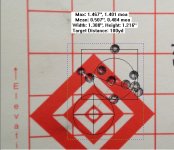QUOTE]I've also heard the varmint tips are pretty good, I was shooting ordinary FMJs and my gun didn't like it very much[[/QUOTE]]
If you want accuracy, look for ammo with decent bullets. 55 gr fmj bullets are not designed for accuracy. Two inch groups for 5 shots at 100 yards from a rest is about as good as you can expect. If you want improved accuracy (and better performance on varmints) and don't want to spend $1.00 or more per round for match ammo, look at the Federal American Eagle Tipped Varmint ammo or the Fiocchi Extrema ammo with the 40 or 50 gr V-MAX bullets. I have had very good results with them in AR's, as well as bolt guns. You should be able to find them for around .50 per round, or even less on sale.
If you want accuracy, look for ammo with decent bullets. 55 gr fmj bullets are not designed for accuracy. Two inch groups for 5 shots at 100 yards from a rest is about as good as you can expect. If you want improved accuracy (and better performance on varmints) and don't want to spend $1.00 or more per round for match ammo, look at the Federal American Eagle Tipped Varmint ammo or the Fiocchi Extrema ammo with the 40 or 50 gr V-MAX bullets. I have had very good results with them in AR's, as well as bolt guns. You should be able to find them for around .50 per round, or even less on sale.

